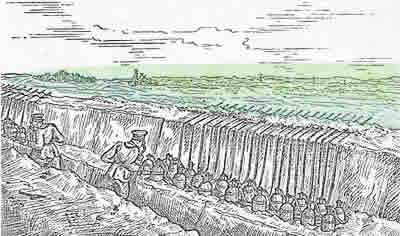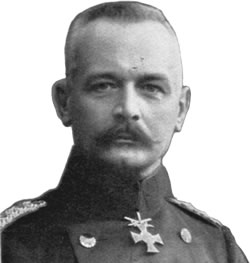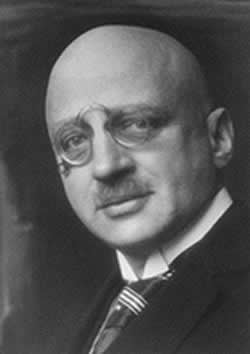New German weapon: the gas cloud
December 1914-January 1915

The idea to create a cloud of gas, which could be blown by the Germans across the enemy's positions, was put forward by the renowned professor Dr Fritz Haber. The drawing shows the method of digging pressurized cylinders containing liquid chlorine into the bottom of a trench. When the valves were opened lead pipes attached to the cylinders could carry the liquid gas to the parapet of the German trench. As soon as the liquid chlorine came into contact with the air it would turn to a gaseous substance. A gentle wind blowing across the enemy's trench lines would then carry the gaseous cloud into the enemy positions.
Secret Weapons and Suspicions
According to ‘Der Weltkrieg 1914-1918’, the German official military history of the First World War, there were constant reports in the early weeks of the war by the foreign press about new inventions and secret weapons which might be used against the German Army. One secret weapon was reportedly invented by French chemist Monsieur Turpin, which could cause injury to a man without making any obvious visible external wound. Similar ideas suggesting the use of an invisible chemical agent had apparently been passed to the Prussian War Ministry at the beginning of the war, but Der Weltkrieg states that they were not taken up.(1)
In the early weeks of the war there were press reports and rumours about inventions and secret weapons. One story was about a secret chemical weapon invented by Monsieur Turpin, which could kill from a range of several hundred metres without causing any visible external wounds. This secret chemical – Turpinite - was mentioned in the Pall Mall Gazette and the Daily Express on 17th September 1914 and in The Times newspaper A so-called photograph appeared some weeks later showing a row of lifeless German soldiers in Belgium, apparently killed by the deadly poison. But, according to the British Military History, there was no proof that these soldiers had died from poisonous chemicals.(2)
Interestingly, Der Weltkrieg states that the Germans were not prepared for the tactics of gas warfare at all in the early months of the war. German research into chemical munitions had, however, been carried out before the war as early as 1887, when the German military had looked into developing non-toxic lacrimators (tear agents).(3) Because of the negative results of the testing and the Hague Convention ruling of 1899 and 1907, the work was stopped.
Official Experiments

|
When the German Minister of War, General Erich von Falkenhayn (1861-1922), took over as Chief of the German General Staff from the ailing General Helmuth von Moltke (1848-1916) on 14th September 1914, he directed that official experiments with chemical weapons should be started. Tests with chemicals were carried out for the German Army from as early as October 1914.
According to Der Weltkrieg 1914-1918 the Germans were prompted to consider chemical warfare for three reasons:
- First, they suspected that the French were already planning to use gas or some similar technique. The Germans maintained that from as early as August 1914 the French had fired gas-diffusing grenades from special 26 calibre rifles — called fusils lance-cartouches éclairantes. The grenades, called “cartouches suffocantes”, contained a tear gas — ethyl bromoacetate. These grenades were of a pre-war design and manufacture and had been used by the police in Paris to put down a riot in 1912. Apparently the French pioneers took 30,000 of the grenades to the fighting front in 1914. There is still a debate as to whether the French did or not use them.
- Second, trench warfare was evolving into a stalemate situation as early as the autumn of 1914. Often the two sides were only a few hundred metres apart. This closeness had increased the difficulty of firing explosive shells into enemy positions before an infantry assault. Often one's own troops would be injured by fragments of shell splinters intended for the other side because they were so close to the bombardment. The effect of high explosive shells had also been reduced because the enemy was digging deeper, better protected shelters. The development of gas by the Germans was therefore a response to the need to create an effective weapon to get the enemy soldier to leave the protection of his trench or bunker, thereby making an enemy position “easily assailable” (the word is “sturmreif” in German).
- Third, even more crucially, the German Supreme Command was facing a serious problem of the dwindling supply of artillery shells, guns and raw material to make explosives even at this early stage of the fighting.
Regarding this last point, the Allied naval blockade of German shipping presented Germany with a problem of how to import much needed raw materials which she relied upon to make her armaments, military and also civilian equipment. Walther Rathenau was head of the electrical firm AEG — Allgemeine Elektrizitätswerke. Within days of the declaration of war he recommended that the War Ministry should set up a Kriegsrohstoffabteilung (KRA) — War Raw Materials Department. He called on other leading industrialists, such as Carl Bosch of BASF and Carl Duisberg of Bayer for their advice and assistance. Rathenau’s department found that Germany had only 6 months’ supply of vital war raw materials. Nitrates for explosives, oil, rubber and various metals were imported. Even though the Army had captured 20,000 tons of saltpeter for making explosives in the port of Antwerp in the early weeks of the war, it would have been difficult to continue the war beyond the spring of 1915 without the possibility of replenishing the stock of ammunition and explosives.
Despite the fact that the rules of the Hague Convention of 1899 and 1907 forbade the use of poisoned weapons in warfare, the Germans began to work on ideas for projectiles containing gas from the autumn of 1914.
The Hague Convention 1899 and 1907
The rules of the 1899 and 1907 Hague Conventions Respecting the Laws and Customs of War on Land forbade the use of both poison and asphyxiating gas.(4) The 1899 Convention rules specifically contained a Declaration about asphyxiating gases; it stated that “the use of projectiles, the sole object of which was the diffusion of asphyxiating gases”, was forbidden. The utilisation of asphyxiating gases as a weapon on their own was, therefore, not allowed.
For a gas to be built into an artillery shell or bullet there was a condition imposed on their usage by the Hague Convention; the debate during the 1899 convention deliberated the wording of the Declaration on asphyxiating gases and concluded that the destructive effect of a shell must be greater than the effect of the gas emitted from it.
The wording of the Declaration was, however, not completely clear in its condemnation of the use of gas in warfare. The 1907 conference agreed to 14 Conventions, number IV of which was the Convention respecting the laws and customs of war on land. It contained Article 23 regarding the means of injuring the enemy. The Declaration, in the form of an Annex to the 1899 Act, simply stated that it is
“especially forbidden … To employ poison or poisoned weapons”
and
“To employ arms, projectiles, or material calculated to cause unnecessary suffering”
The wording was open to the possibility that its meaning could be questioned with regard to:
- what gas did actually constitute a poison?
- what scale of human casualties was permissible below the designation of “mass slaughter”?
- was its use and further development justifiable in circumstances of retaliation?
- if a gas was produced with the purpose of engulfing an enemy position would it be regarded as a weapon if it had no explosive element?
A German Sneezing Powder Shell (“Ni-Shell”)
It was the Chief of the Heavy Artillery and Fortress Section in the Operations Branch at the OHL, Major Max Bauer(5), who suggested the concept of a “massenwirkung” — mass effect — means of using gas to “persuade” Allied troops to leave their defensive line. (6)
Bauer’s idea was to find something that could work its way through sandbags and dugouts. Bauer’s papers say that General Falkenhayn was interested because, after the disappointment of the Battle of the Marne and the limitations on supplies for the artillery, he was looking for a way to break the Allied defensive line and create a war of movement again. According to Bauer, it was Falkenhayn who made the decision to investigate chemical munitions, with instructions to Bauer to start up research into ways of generating smoke, fire or lachrymatory agents (tear gas). In early October 1914 Bauer set up a meeting with Army officers and some of the leading civilian chemists at the Köln-Wahn Truppenübungsplatz on the Wahner-Heide heath south-east of Cologne. This was a large military training ground including artillery ranges and an airfield.(7)
The task of Bauer’s team was to develop a chemical shell as an incendiary, smoke or stink device to drive the enemy out of his entrenchments. Two civilian experts were invited: Hermann Walther Nernst, Professor of Physical Chemistry at the University of Berlin, and Carl Duisberg, Chief Executive of Friedrich Bayer & Co. in nearby Leverkusen. Max Bauer knew Duisberg. He approached him because he hoped to get financial and practical support for his military projects from Bayer & Co., one of the leading pharmaceutical manufacturers in Europe. It is believed to have been Duisberg who suggested trying out an irritant, non-toxic powder called dianisidine chlorosulfonate. This was a chemical powder manufactured by Bayer & Co. and the powder was intended to have a lachrymatory — tear gas — effect on the enemy’s mucous membranes. The main effect caused by breathing in this powder was violent sneezing. Professor Nernst(8) devised a way of placing 550g of the powder around the shrapnel balls in a traditional 105mm shell so that when the shell exploded it would create a cloud of irritant powder.
The fact that there was shrapnel and explosive in the shell enabled the Germans to exploit a loophole in the Hague Convention for the laws and customs of war on land. As mentioned earlier, the Convention had banned the use of any weapon with the “sole” purpose of disseminating a chemical on the battlefield.
The codename given to the shell was “Ni-Schrapnell”. Nernst’s name began with a “N” and the German word for sneezing is “niesen”. So the N and “niesen” were combined into “Ni”. Several hundred kilos of the chemical were ordered from Bayer & Co. and filled into 105mm shells.
The “Ni-Shell” was first tested against the Allies when some 3,000 shells were fired at British and Indian troops in the Neuve Chapelle area of the Western Front on 27th October 1914. It was not rated as an effective weapon as it had no ill-effect on the recipients. The authors of ‘Gas! The Battle for Ypres 1915’ relate an amusing incident whereby General von Falkenhayn's son won himself a crate of champagne in a bet that he could last for five finutes unprotected in a cloud of the irritant.(9)
The German “T-Shell”
Within a few months, by December 1914, the Germans had begun to test a 15cm shell called the T-Granate or the T-Shell in English, and named after the chemist who developed it, Hans Tappen. This not only contained explosives but also a liquid irritant chemical called xylyl bromide. The chemical was provided again by Bayer & Co.
The “T-Shell” was tried out for the first time against the Russian Army on the Eastern Front on 30th January 1915. The unsuccessful result was due to the fact that the cold weather affected the substance of the chemical and rendered it ineffective. In addition, the mass production of shells by the German war industry was small at that time and German Supreme Command was unsure whether gas shells could be produced on a large enough scale to provide for a substantial artillery bombardment which could turn this gas shell into a “mass-effect” offensive weapon.
“T-Stoff” became the codename given to xylyl and benzyl bromide, named again after Tappen (it was later called White Cross).
The Idea for a Cloud of Gas

|
In the winter of 1914/1915 it was the chemist Professor Dr. Fritz Haber (1868-1934) who came up with the idea of generating a cloud of gas to engulf the enemy line. Fritz Haber was Director of the Kaiser Wilhelm Institute for Physical Chemistry and Electrochemistry at Dahlem, near Berlin.(10)
Before the outbreak of war Dr Fritz Haber and Carl Bosch had worked together to develop the “Haber Process”. This is the catalytic formation of ammonia from hydrogen and nitrogen from the atmoshpere. For this work he was awarded the Nobel Prize in Chemistry at the end of the war in 1918. The major advances made by Haber in the world of industrial chemistry before the war were, however, set against the work he carried out for Imperial Germany during the war. His development of chemical warfare as a means to an end and his defence of the use of poisonous gas on enemy troops earned him the title of the “Father of Modern Chemical Warfare”.
In December 1914 Haber had watched the test firing of the T-Shells at the Kummersdorf artillery ranges near Berlin. Haber did not consider that the dispersal of the “T-Stoff” — xylyl bromide — would be effective on a large-scale via howitzer shells. He suggested grouping trench mortars together and firing bombs containing “T-Stoff”. This is a similar idea to the batteries of the later British Livens’ projectors.
Haber was told that large numbers of mortars or bombs were not available. Being a practical man he began to look for a solution. His thoughts turned to other methods of dispersal for which the equipment could be obtained quickly and easily.
In mid December, Fritz Haber approached Falkenhayn with a new idea. Haber proposed a “Blasangriff”. This is an attack using the dispersion delivery of a cloud of a poisonous gas. This is the simplest technique of chemical delivery whereby the agent is placed on or close to the target just before dissemination, ensuring the most efficient use of the agent.
The technique involved releasing a liquid chemical from pressurized bottles dug into the German front line. When the liquid chemical was released from the bottles it would come into contact with air and it would turn into gas. A favourable wind could then carry the gas across no-man's-land and into the enemy trenches. By blowing it from bottles in a front line trench it was thought to be possible to create a chlorine cloud, which would creep across the ground in enough measure to create a mass effect. Some would inevitably blow away, but this was considered to be a positive aspect; once the main cloud had done its work in knocking out the enemy troops, the German attacking soldiers could follow on quickly without too much risk to themselves. The chlorine gas itself was intended to render the enemy troops incapable of fighting but it was not considered to have a lasting physical effect on the men.
The chemical suggested by Dr. Haber was liquid chlorine. The Swedish chemist Karl Wilhelm Scheele had discovered chlorine in 1774. It was another 36 years (1810) before Sir Humphry Davy established that the gas was a pure element. He named the yellow-green gas “chlorine” from the Greek word “chloros”, which means green-yellow.
German Supreme Command allowed Dr. Haber to get to work on the development of this new weapon. From a practical point of view Haber’s choice of chlorine was a commercially available chemical, whose properties and effects were already known. It could be sourced easily and cheaply from existing suppliers. Manufactured by the electrolysis of common salt [NaCl], chlorine was widely used in the German domestic economy as a bleaching agent, for the industrial production of paper, textiles and most importantly for dyestuffs. Before 1914 German chemical manufacturing companies were making 40 tons of chlorine a day. It was, therefore, possible to make this chemical up in large quantities within the German domestic economy (the dye industry) without having to do it in secret.
Haber suggested he should have access to the 12,000 or so commercial gas bottles already in existence in Germany. Since the 1880s BASF had supplied German companies with liquid chlorine in iron cylinders as an industrial bleaching agent, for the manufacture of indigo, sulfur black and other organic chemicals. In the USA and Britain it was generally only available as a powder until shortly before the Great War. The large commercial cylinders were about 1.20m-1.50m tall and heavy — about 85 kg.
Together with the development of the chlorine gas weapon, work was also carried out to develop effective gas-masks and breathing apparatus.
Next >> Trial of the new gas weapon
Acknowledgments
(1) Der Weltkrieg 1914-1918: Sommer und Herbst 1915, 8. Band
(2) British Military Operations: France and Belgium 1915, p. 193
(3) Gas! The Battle for Ypres 1915, p. 21
(4) For details of the 1899 and 1907 Hague Conventions see the ICRC (International Committee of the Red Cross) website International Humanitarian Law - Treaties and Documents, specifically the 1899 Hague Convention and the 1907 Hague Convention.
(5) The Poisonous Cloud, p 24
(6) Between Genius and Genocide, p. 152
(7) Nowadays it is a nature conservation area with a museum in the old barracks and it is part of the Köln-Bonn airport. For a history (in German) of this military training ground Truppenübungsplatz Wahn see the website by H Felder www.porz-am-rhein.de/potrup.html
(8) Both of Professor Nernst’s sons, Rudolf and Gustav, were killed in the Great War.
(9) Gas! The Battle for Ypres 1915, p. 22
(10) This is now the Fritz-Haber-Institute of the Max-Planck Society. For a history of the Institute see the Historical Review of the Fritz Haber Institute
Photograph of Professor Dr Fritz Haber courtesy of Wikimedia Commons.